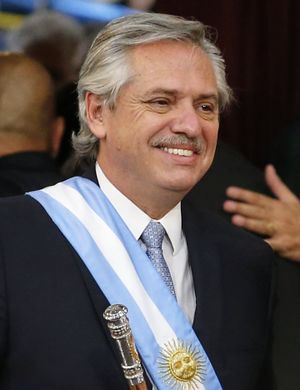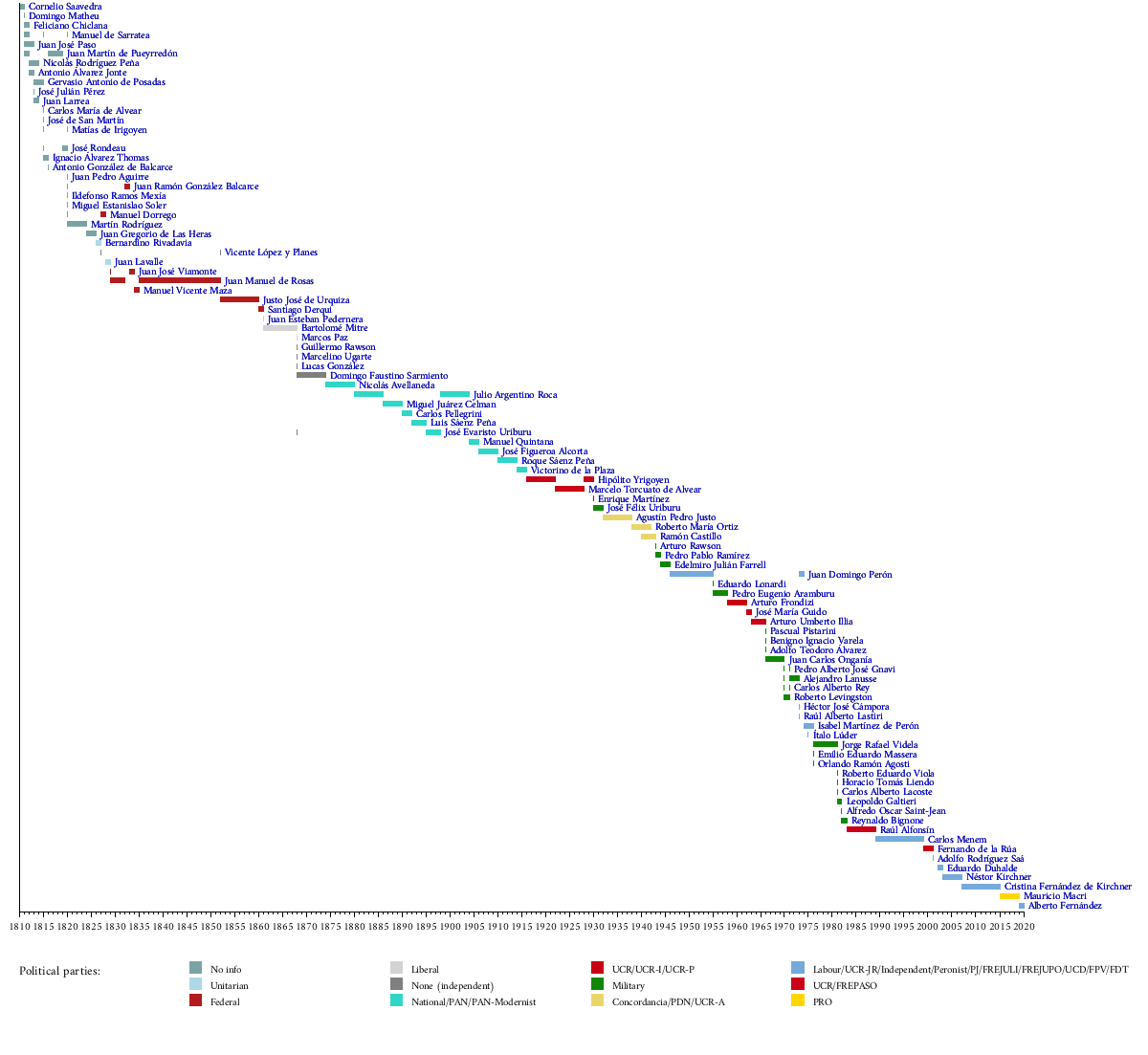قائمة رؤوس دولة الأرجنتين
| رئيس الأمة الأرجنتينية
Presidente de la Nación Argentina | |
|---|---|
 المعيار الرئاسي | |
| الأسلوب | صاحب السعادة (م) صاحب السعادة (ف) |
| المقر | كازا روزادا (مكتب حكومي) كوينتا دي أوليڤوس (الإقامة الرسمية) تشابادمال ريزيدنس (منزل صيفي) |
| طول المدة | أربع سنوات قابلة للتجديد مرة واحدة |
| الشاغل الافتتاحي | برناردينو ريڤاداڤيا |
| التشكل | الأول: دستور 1826 الحالي: دستور 1853 , (تم تعديله في 1994). |
| الراتب | 77,855.65 پـِسو أرجنتينيs[1] (as of February 2016) |
| الموقع الإلكتروني | Office of the President |
الأرجنتين لديها العديد من الأنواع المختلفة من رؤساء الدول بالإضافة إلى أنواع مختلفة من الحكومات. خلال فترة ما قبل كولومبوس ، كانت الأراضي التي تشكل الأرجنتين اليوم مأهولة بقبائل بدوية دون أي حكومة محددة. خلال الاستعمار الإسباني للأمريكتين ، احتفظ ملك إسبانيا بالسلطة المطلقة على الأراضي التي تم غزوها في العالم الجديد ، بتعيين نائب الملك للحكومة المحلية. كانت الأقاليم التي أصبحت فيما بعد الأرجنتين الجزء الأول من نائبية پيرو ثم نائبية ريو دلا پلاتا. بدأت ثورة مايو حرب الاستقلال الأرجنتينية عن طريق استبدال نائب الملك بلتزار هيدالگو ده سيسنروس بالحكومة الوطنية الأولى. كانت پريمـِرا خونتا من عدة أعضاء ، والتي ستنمو لتصبح مجلس كبير مع دمج نواب المقاطعات. أعطى حجم المجلس العسكري مساحة للخلافات السياسية الداخلية بين أعضائها ، لذلك تم استبدالهم بالثلاثي الأول والثاني ، من ثلاثة أعضاء.. أنشأت جمعية العام الثالث عشر سلطة تنفيذية جديدة ، مع سمات مشابهة لتلك التي لرئيس الدولة ، ودعا المدير الأعلى للمقاطعات المتحدة لريو دي لا بلاتا . الجمعية الثانية ، مؤتمر توكومان ، الإعلان عن الأستقلال في عام 1816 وأصدر الدستور الأرجنتيني لعام 1819. ومع ذلك ، تم إلغاء هذا الدستور خلال النزاعات المسلحة بين الحكومة المركزية و الرابطة الفيدرالية. بدأت هذه الفترة المعروفة باسم فوضوية السنة XX ، عندما كانت الأرجنتين تفتقر إلى أي نوع من رؤساء الدولة.
مفاتيح الانتساب
| Abbreviation | Party name (English) | Party name (Spanish) | Years | |
|---|---|---|---|---|
| Unitarian | Unitarian | Unitarios | 1826–1827, 1828–1829 | |
| Federal | Federalist | Federales | 1827–1828, 1829–1861 | |
| Liberal | Liberal Party | Partido Liberal | 1862–1868 | |
| — | Independent politician | Político independiente | 1868–1874 | |
| National | National Party | Partido Nacional | 1874–1880 | |
| PAN | National Autonomist Party | Partido Autonomista Nacional | 1880–1910, 1914–1916 | |
| PAN-Modernist | National Autonomist Party – Modernist Line | Partido Autonomista Nacional – Línea Modernista | 1910–1914 | |
| UCR | Radical Civic Union | Unión Cívica Radical | 1916–1930, 1958–1966, 1983–1989, 1999–2001 | |
| Military | Armed Forces of the Argentine Republic | Fuerzas Armadas de la República Argentina | 1930–1932, 1943–1946, 1955–1958, 1966–1973, 1976–1983 | |
| Concordancia | Concordancia | Concordancia | 1932–1943 | |
| PDN | National Democratic Party | Partido Demócrata Nacional | 1932–1938, 1942–1943 | |
| UCR-A | Antipersonalist Radical Civic Union | Unión Cívica Radical Antipersonalista | 1938–1942 | |
| Labour | Labour Party | Partido Laborista | 1946–1952 | |
| UCR-JR | Radical Civic Union Renewal Board | Unión Cívica Radical Junta Renovadora | 1946–1952 | |
| Independent | Independent Party | Partido Independiente | 1946–1952 | |
| Peronist | Peronist Party | Partido Peronista | 1952–1955 | |
| UCR-I | Intransigent Radical Civic Union | Unión Cívica Radical Intransigente | 1958–1963 | |
| UCR-P | People's Radical Civic Union | Unión Cívica Radical del Pueblo | 1963–1966 | |
| PJ | Justicialist Party | Partido Justicialista | 1973–1976, 1989–1999, 2001–2015, 2019–present | |
| FREJULI | Justicialist Liberation Front | Frente Justicialista de Liberación | 1973–1976 | |
| FREJUPO | Justicialist Front of Popular Unity | Frente Justicialista de Unidad Popular | 1989–1995 | |
| UCD | Union of the Democratic Centre | Unión del Centro Democrático | 1995–1999 | |
| Alianza | Alliance for Work, Justice and Education | Alianza para el Trabajo, la Justicia y la Educación | 1999–2001 | |
| FPV | Front for Victory | Frente para la Victoria | 2003–2015 | |
| PRO | Republican Proposal | Propuesta Republicana | 2015–2019 | |
| Cambiemos | Cambiemos | Cambiemos | 2015–2019 | |
| FDT | Everyone's Front | Frente de Todos | 2019–present | |
المقاطعات المتحدة لريو دي لا بلاتا (1810-1831)
رؤساء المجلس العسكري (1810-1811)
| Portrait | Name (Birth–Death) |
Term of office | Notes |
R. | |
|---|---|---|---|---|---|
| Start | End | ||||
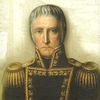
|
Cornelio Saavedra (1759–1829) |
25 May 1810 | 18 December 1810 | President of the Primera Junta, at the beginning of the Argentine War of Independence. He is regarded as the first president of a national government.[2] | [3] |
| 18 December 1810 | 26 August 1811 | President of the Junta Grande. Left to serve in the Army of the North. | |||
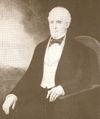
|
Domingo Matheu (1765–1831) |
26 August 1811 | 23 September 1811 | President of the Junta Grande, from Saavedra's departure to the dissolution of it. | [4] |
الحكم الثلاثي (1811–1814)
| الحكم الثلاثي الأول 23 سبتمبر 1811 – 8 أكتوبر 1812 | |||
|---|---|---|---|
| 23 سبتمبر 1811 – 23 مارس 1812 | 23 مارس 1812 – 8 أكتوبر 1812 | ||
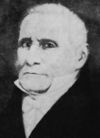 Feliciano Chiclana (1761–1826) | |||
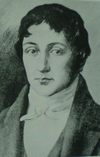 Manuel de Sarratea (1774–1849) | |||
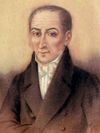 Juan José Paso (1758–1833) |
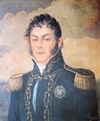 Juan Martín de Pueyrredón (1776–1850) | ||
| الحكم الثلاثي الثاني 8 أكتوبر 1812 – 31 يناير 1814 | |||
|---|---|---|---|
| 8 أكتوبر 1812 – 20 فبراير 1813 | 20 February 1813 – 19 August 1813 | 19 August 1813 – 5 November 1813 | 5 November 1813 – 31 January 1814 |
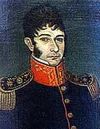 Nicolás Rodríguez Peña (1775–1853) | |||
 Antonio Álvarez Jonte (1784–1820) |
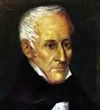 Gervasio Antonio de Posadas (1757–1833) | ||
 Juan José Paso (1758–1833) |
José Julián Pérez (1770–1840) |
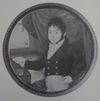 Juan Larrea (1782–1847) | |
كبار المديرين (1814-1820)
| Portrait | Name (Birth–Death) |
Term of office | Notes |
R. | |
|---|---|---|---|---|---|
| Start | End | ||||

|
Gervasio Antonio de Posadas (1757–1833) |
31 January 1814 | 9 January 1815 | Chosen by the Assembly of the Year 1813. | [5] |
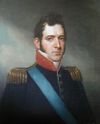
|
Carlos María de Alvear (1789–1852) |
9 January 1815 | 18 April 1815 | Forced to resign by a mutiny. | [6] |
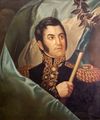 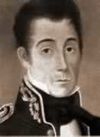 
|
José de San Martín (1778–1850) Matías de Irigoyen (1781–1839) Manuel de Sarratea (1774–1849) |
18 April 1815 | 20 April 1815 | Third Triumvirate. Interim government until the appointment of a new Supreme Director. | |
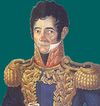
|
José Rondeau (1773–1844) |
20 April 1815 | 21 April 1815 | Appointed successor of Alvear, could not take office because he was in command of the Army of the North | [7] |
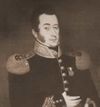
|
Ignacio Álvarez Thomas (1787–1857) |
21 April 1815 | 16 April 1816 | Acting, for Rondeau. Convened the Congress of Tucumán, that would declare Independence. | [8] |
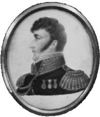
|
Antonio González de Balcarce (1774–1819) |
16 April 1816 | 9 July 1816 | Interim. | [9] |

|
Juan Martín de Pueyrredón (1776–1850) |
9 July 1816 | 9 June 1819 | First Argentine Head of State after the Argentine Declaration of Independence. Supported the Crossing of the Andes. | [10] |

|
José Rondeau (1773–1844) |
9 June 1819 | 1 February 1820 | Decisively defeated at the Battle of Cepeda by Federalist forces opposed to the 1819 centralist Constitution. | [11] |
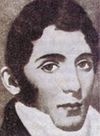
|
Juan Pedro Aguirre (1781–1837) |
1 February 1820 | 11 February 1820 | Interim. Dissolved the National Congress and endorsed the Buenos Aires Cabildo to choose a Governor for Buenos Aires Province instead of the previous post of Governor Mayor. | |
حكام مقاطعة بوينس آيرس يديرون العلاقات الدولية (1820-1826)
Between 1820 and 1826, the United Provinces functioned as a loose alliance of autonomous provinces put together by pacts and treaties (see Treaty of Pilar, Treaty of Benegas, Quadrilateral Treaty), but lacking any actual central government until the 1825 Constitutional Congress.
| Portrait | Name (Birth–Death) |
Term of office | Notes |
R. | |
|---|---|---|---|---|---|
| Start | End | ||||

|
Matías de Irigoyen (1781–1839) |
11 February 1820 | 18 February 1820 | He had been Governor Mayor from 9 to 11 February 1820 and was promoted interim as Governor until the appointment of Manuel de Sarratea. | |
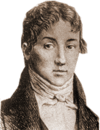
|
Manuel de Sarratea (1774–1849) |
18 February 1820 | 6 March 1820 | The political crisis that existed in the country led to his government lacked support from both Buenos Aires and the other provinces. Thus he resigned shortly afterwards. | |
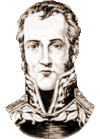
|
Juan Ramón Balcarce (1773–1836) |
6 March 1820 | 11 March 1820 | Interim. Resigned. | |

|
Manuel de Sarratea (1774–1849) |
11 March 1820 | 2 May 1820 | He returned to office after the end of the brief government of Balcarce. The circumstances did not improve and ended up resigning a second time. | |
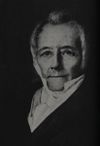
|
Ildefonso Ramos Mexía (1769–1854) |
2 May 1820 | 20 June 1820 | ||
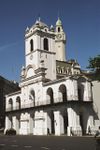
|
Ildefonso Ramos Mexía and Miguel Estanislao Soler | 20 June 1820 | 23 June 1820 | They took power simultaneously. | |
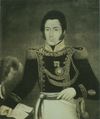
|
Miguel Estanislao Soler (1783–1849) |
23 June 1820 | 29 June 1820 | He assumed de facto, after an armed uprising, but his government lasted a few days, when the Board of Representatives appointed Manuel Dorrego. | |
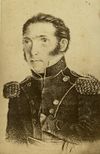
|
Manuel Dorrego (1787–1828) |
29 June 1820 | 20 September 1820 | Interim. | |
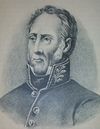
|
Martín Rodríguez (1771–1845) |
20 September 1820 | 2 April 1824 | He signed the Treaty of Benegas and the Quadrilateral. | |
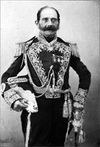
|
Juan Gregorio de las Heras (1780–1866) |
2 April 1824 | 7 February 1826 | He called a Constituent Congress that enacted several laws for which the Unitary Republic was proclaimed. He resigned because of that republic. | |
الحكومة الرئاسية الأولى (1826-1827)
| Portrait | Name (Birth–Death) |
Term of office | Political party |
Notes |
R. | ||
|---|---|---|---|---|---|---|---|
| Start | End | ||||||
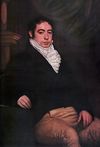
|
Bernardino Rivadavia (1780–1845) |
8 February 1826 | 27 June 1827 | Unitarian | Elected by the Constituent Assembly of 1826, before the promulgation of the 1826 constitution.[12] Waged the Cisplatine War. Resigned as the Constitution was rejected by the provinces and the outcome of the war generated popular discontent. | [12] | |
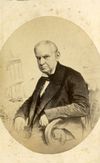
|
Vicente López y Planes (1785–1856) |
7 July 1827 | 18 August 1827 | — | Elected as interim president by the Constituent Assembly of 1826. His mandate was limited to close the Assembly and call for elections for a new governor of Buenos Aires. | [12] | |
حكام مقاطعة بوينس آيرس يديرون العلاقات الدولية (1827-1831)
| Portrait | Name (Birth–Death) |
Term of office | Political party |
Notes |
R. | ||
|---|---|---|---|---|---|---|---|
| Start | End | ||||||
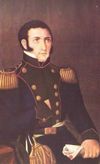
|
Manuel Dorrego (1787–1828) |
18 August 1827 | 1 December 1828 | Federal | Ended the Cisplatine War. Deposed and executed by Juan Lavalle. | [13] | |
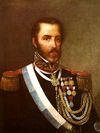
|
Juan Lavalle (1797–1841) |
1 December 1828 | 26 June 1829 | Unitarian | Coup d'état. Defeated in battle, resigned under siege | [14] | |
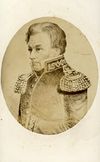
|
Juan José Viamonte (1774–1843) |
26 June 1829 | 6 December 1829 | Federal | Interim. | [15] | |
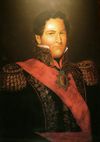
|
Juan Manuel de Rosas (1793–1877) |
6 December 1829 | 4 January 1831 | Federal | First term. Convened the Federal Pact and waged war against the Unitarian League. | [16] | |
الاتحاد الأرجنتيني (1831-1861)
الحكام الذين يديرون العلاقات الدولية (1831-1852)
| Portrait | Name (Birth–Death) |
Term of office | Political party |
Notes |
R. | ||
|---|---|---|---|---|---|---|---|
| Start | End | ||||||

|
Juan Manuel de Rosas (1793–1877) |
4 January 1831 | 5 December 1832 | Federal | Governor of Buenos Aires Province. First term. Convened the Federal Pact and waged war against the Unitarian League. Resigned. | [16] | |

|
Juan Ramón Balcarce (1773–1836) |
5 December 1832 | 4 November 1833 | Federal | Governor of Buenos Aires Province. Ousted by the Revolution of the Restorers. | [17] | |

|
Juan José Viamonte (1774–1843) |
4 November 1833 | 27 June 1834 | Federal | Governor of Buenos Aires Province. Interim. | [18] | |

|
Manuel Vicente Maza (1779–1839) |
27 June 1834 | 7 March 1835 | Federal | Governor of Buenos Aires Province. Interim. | [19] | |

|
Juan Manuel de Rosas (1793–1877) |
7 March 1835 | 3 February 1852 | Federal | Governor of Buenos Aires Province with the sum of public power. Waged the Argentine and Uruguayan Civil Wars, the War of the Confederation and the French and Anglo-French blockade of the Río de la Plata. Designated "Supreme Chief of the Argentine Confederation" in 1851. Defeated by Justo José de Urquiza at the Battle of Caseros. Resigned. | [20] | |

|
Vicente López y Planes (1785–1856) |
3 February 1852 | 6 April 1852 | — | Governor of Buenos Aires Province. Interim. Governor of Buenos Aires Province without national powers until 26 July 1852. | ||
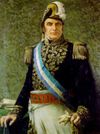
|
Justo José de Urquiza (1801–1870) |
6 April 1852 | 31 May 1852 | Federal | Governor of Entre Ríos Province. | ||
المدير المؤقت لاتحاد الأرجنتين (1852-1854)
| Portrait | Name (Birth–Death) |
Term of office | Political party |
Notes |
R. | ||
|---|---|---|---|---|---|---|---|
| Start | End | ||||||

|
Justo José de Urquiza (1801–1870) |
31 May 1852 | 5 March 1854 | Federal | At the same time Governor of Buenos Aires Province between 26 July 1852 and 4 September 1852. The Province of Buenos Aires secedes from the Confederation as the State of Buenos Aires on 11 September 1852. Ratification of the Constitution of 1 May 1853 by all the provinces, except Buenos Aires. | [21] | |
رؤساء الاتحاد (1854-1861)
| Portrait | Name (Birth–Death) |
Term of office | Elections | Political party |
Notes |
Vice President | R. | ||
|---|---|---|---|---|---|---|---|---|---|
| Start | End | ||||||||

|
Justo José de Urquiza (1801–1870) |
5 March 1854 | 5 March 1860 | 1854 | Federal | Indirect elections. The reincoporation of the State of Buenos Aires was negotiated after the 1859 Battle of Cepeda in the Pact of San José de Flores. First constitutional President of Argentina. | Salvador María del Carril | [21] | |
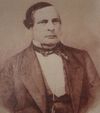
|
Santiago Derqui (1809–1867) |
5 March 1860 | 5 November 1861 | 1860 | Federal | Indirect elections. On 18 October 1860, a Constitutional reform is adopted, proclaiming the Argentine Republic. Resigned after the failure of the Pact of San José de Flores and the national government lost in the Battle of Pavón to Buenos Aires. | Juan Esteban Pedernera | [22] | |
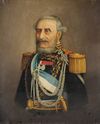
|
Juan Esteban Pedernera (1796–1886) |
5 November 1861 | 12 December 1861 | — | Unitarian | Vice President under Derqui, assumed the presidency after his resignation. Resigned on the dissolution of the national government. | Vacant | [22] | |
جمهورية الأرجنتين (1861– الآن)
الرؤساء (1861– الآن)
| الپورتريه | الاسم (المولد-الوفاة) |
مدة المنصب | الانتخابات | الحزب (التحالف) |
ملاحظات | نائب الرئيس | R. | ||
|---|---|---|---|---|---|---|---|---|---|
| البداية | النهاية | ||||||||
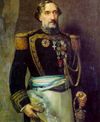
|
Bartolomé Mitre (1821–1906) |
12 December 1861 | 12 أبريل 1862 | — | Liberal | Governor of Buenos Aires Province de facto in charge of the National Executive Power after the Battle of Pavón and the resignation of Juan Esteban Pedernera. During the following months provinces give Mitre different powers.[note 1] | شاغر | [23] | |
| 12 أبريل 1862 | 2 يونيو 1862 | — | After gaining support from the provinces he appointed himself by decree as "Governor of Buenos Aires Province in charge of the National Executive Power". | [24] | |||||
| 2 يونيو 1862 | 12 أكتوبر 1862 | — | The National Congress appoints the Governor of Buenos Aires Province, in this case Mitre, as the person in charge of the National Executive Power, until new elections are held. | [25] | |||||
| 12 أكتوبر 1862 | 12 أكتوبر 1868 | 1862 | Liberal Nacionalist |
Indirect elections with Mitre as the only candidate. First president of the unified country. Waged the War of the Triple Alliance. | Marcos Paz (Died 2 January 1868) |
[26] | |||
| شاغر | |||||||||

|
Marcos Paz (1811–1868) |
12 يونيو 1865 | 2 يناير 1868 | — | Liberal | Vice President under Mitre. Acting president as Mitre commanded the army in the War of the Triple Alliance. Died in office. | نفسه | ||
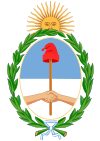
|
مجلس وزراء | 2 يناير 1868 | 18 يناير 1868 | — | — | After the death of Marcos Paz, ministers coordinated by the Minister of the Interior dictated the acts of government until Mitre returned from Paraguay. Members: |
شاغر | ||
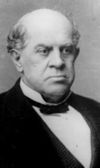
|
Domingo Faustino Sarmiento (1811–1888) |
12 أكتوبر 1868 | 12 أكتوبر 1874 | 1868 | — | Indirect elections. Ended the War of the Triple Alliance. | Adolfo Alsina | [26] | |
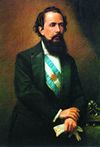
|
Nicolás Avellaneda (1837–1885) |
12 أكتوبر 1874 | 12 أكتوبر 1880 | 1874 | National ↓ PAN |
Indirect elections. Federalization of Buenos Aires City in سبتمبر 1880. | Mariano Acosta | [26] | |
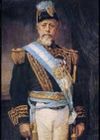
|
Julio Argentino Roca (1843–1914) |
12 أكتوبر 1880 | 12 أكتوبر 1886 | 1880 | PAN | Indirect elections. First term. End of the Argentine Civil Wars. | Francisco Bernabé Madero | [27] | |
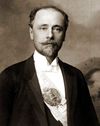
|
Miguel Ángel Juárez Celman (1844–1909) |
12 أكتوبر 1886 | 6 أغسطس 1890 | 1886 | PAN | Indirect elections. Resigned following the Revolution of the Park. | Carlos Pellegrini | [28] | |
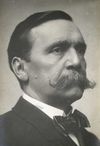
|
Carlos Pellegrini (1846–1906) |
6 أغسطس 1890 | 12 أكتوبر 1892 | — | PAN | Vice President under Juárez Celman, assumed the presidency after his resignation. Finished the presidential period 1886–1892. | شاغر | [28] | |
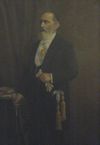
|
Luis Sáenz Peña (1822–1907) |
12 أكتوبر 1892 | 22 يناير 1895 | 1892 | PAN | Indirect elections. Government victory in the Revolution of 1893. Resigned. | José Evaristo Uriburu | [29] | |
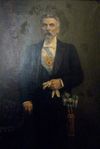
|
José Evaristo Uriburu (1831–1914) |
22 يناير 1895 | 12 أكتوبر 1898 | — | PAN | Vice President under Sáenz Peña, assumed the presidency after his resignation. Finished the presidential period 1892–1898. | شاغر | [29] | |

|
Julio Argentino Roca (1843–1914) |
12 أكتوبر 1898 | 12 أكتوبر 1904 | 1898 | PAN | Indirect elections. Second term. | Norberto Quirno Costa | [30] | |
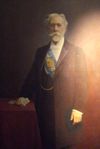
|
Manuel Quintana (1835–1906) |
12 أكتوبر 1904 | 12 مارس 1906 | 1904 | PAN | Indirect elections. Government victory in the Revolution of 1905. Died in office. | José Figueroa Alcorta | [31] | |
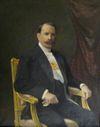
|
José Figueroa Alcorta (1860–1931) |
25 يناير 1906 | 12 مارس 1906 | — | PAN | Vice President under Quintana. Acting president during his illness. | نفسه | [31] | |
| 12 مارس 1906 | 12 أكتوبر 1910 | — | Vice President under Quintana, assumed the presidency after his death. Finished the presidential period 1904–1910. | شاغر | |||||
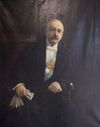
|
Roque Sáenz Peña (1851–1914) |
12 أكتوبر 1910 | 9 أغسطس 1914 | 1910 | PAN Modernist |
Indirect elections. Promoted the Sáenz Peña law, which allowed secret, universal and mandatory suffrage. Died in office. | Victorino de la Plaza | [32] | |
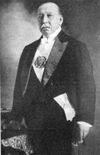
|
Victorino de la Plaza (1840–1919) |
9 أغسطس 1914 | 12 أكتوبر 1916 | — | PAN | Vice President under Sáenz Peña, assumed the presidency after his death. Finished the presidential period 1910–1916. | شاغر | [32] | |
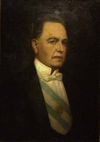
|
Hipólito Yrigoyen (1852–1933) |
12 أكتوبر 1916 | 12 أكتوبر 1922 | 1916 | UCR | Free indirect elections. First president elected under the Sáenz Peña law. First term. Maintained neutrality during World War I. | Pelagio Luna (Died 25 June 1919) |
[33] | |
| شاغر | |||||||||
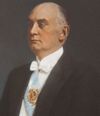
|
Marcelo Torcuato de Alvear (1868–1942) |
12 أكتوبر 1922 | 12 أكتوبر 1928 | 1922 | UCR | Free indirect elections. | Elpidio González | [33] | |
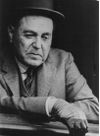
|
Hipólito Yrigoyen (1852–1933) |
12 أكتوبر 1928 | 6 سبتمبر 1930 | 1928 | UCR | Free indirect elections. Second term, ousted from office by a coup d'état. | Enrique Martínez | [34] | |
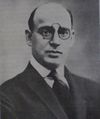
|
Enrique Martínez (1887–1938) |
5 سبتمبر 1930 | 6 سبتمبر 1930 | — | UCR | Vice President under Yrigoyen. Acting president during his illness. Ousted from office by a coup d'état. | نفسه | ||
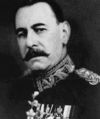
|
José Félix Uriburu (1868–1932) |
6 سبتمبر 1930 | 20 فبراير 1932 | — | Military | First coup d'état in modern Argentine history. Beginning of the Infamous Decade. Called for elections. | Enrique Santamarina (Resigned 20 October 1930) |
[35] | |
| شاغر | |||||||||
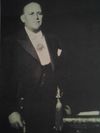
|
Agustín Pedro Justo (1876–1943) |
20 فبراير 1932 | 20 فبراير 1938 | 1931 | PDN (Concordancia) |
Indirect elections held with fraud and with the UCR barred from elections. | Julio Argentino Pascual Roca | [36] [37] | |
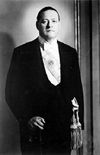
|
Roberto María Ortiz (1886–1942) |
20 فبراير 1938 | 27 يونيو 1942 | 1937 | UCR-A (Concordancia) |
Indirect elections held with fraud. Resigned for health reasons, died one month later. | Ramón Castillo | [38] [39] | |
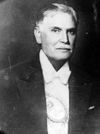
|
Ramón Castillo (1873–1944) |
3 July 1940 | 27 يونيو 1942 | — | PDN (Concordancia) |
Vice President under Ortiz. Acting president during his illness. | نفسه | [38] | |
| 27 يونيو 1942 | 4 يونيو 1943 | — | Vice President under Ortiz, assumed the presidency after his resignation. Deposed in a coup d'état. End of the Infamous Decade. | شاغر | |||||
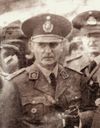
|
Arturo Rawson (1885–1952) |
4 يونيو 1943 | 7 يونيو 1943 | — | Military | Coup d'état. Beginning of the Revolution of '43. Ousted from office. | [40] [38] | ||
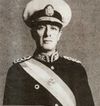
|
Pedro Pablo Ramírez (1884–1962) |
7 يونيو 1943 | 9 مارس 1944 | — | Military | Coup d'état. On 25 فبراير 1944, Ramírez temporarily delegated powers to Edelmiro Farrell. Resigned. | Sabá Sueyro (Died 15 October 1943) |
[38] | |
| Edelmiro Julián Farrell | |||||||||
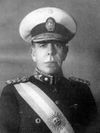
|
Edelmiro Julián Farrell (1887–1980) |
25 فبراير 1944 | 9 مارس 1944 | — | Military | Vice President under Ramírez. Acting president. | نفسه | [38] | |
| 9 مارس 1944 | 4 يونيو 1946 | — | Declared war to the Axis powers. Called for elections. End of the Revolution of '43.
|
شاغر | |||||
| Juan Perón (8 July 1944–10 October 1945) | |||||||||
| Juan Pistarini | |||||||||

|
Juan Perón (1895–1974) |
4 يونيو 1946 | 4 يونيو 1952 | 1946 | Labour (UCR-JR) (Independent) |
Free indirect elections. First term. Reelection enabled by the Constitution of 1949. | Hortensio Quijano (Died 3 April 1952) |
[41] | |
| شاغر | |||||||||
| 4 يونيو 1952 | 19 سبتمبر 1955 | 1951 | Peronist | Free direct elections. Second term. First election to allow women's suffrage. Victory with 62.49% of votes, highest victory in Argentine elections. Ousted from office by a coup d'état. | |||||
| Alberto Teisaire (7 May 1954–16 September 1955) | |||||||||
| شاغر | |||||||||
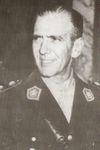
|
Eduardo Lonardi (1896–1956) |
20 سبتمبر 1955 | 23 نوفمبر 1955 | — | Military | Coup d'état. Beginning of the Revolución Libertadora. By decree appointed himself as "Provisional President of the Nation". | [42] | ||
| 23 سبتمبر 1955 | 13 نوفمبر 1955 | — | Lonardi is sworn in as President. Ousted from office. | Isaac Rojas | |||||
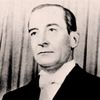
|
Pedro Eugenio Aramburu (1903–1970) |
13 نوفمبر 1955 | 1 مايو 1958 | — | Military | Coup d'état. The 1949 Constitution is repealed and the 1853 Constitution is restored. End of the Revolución Libertadora. Called for elections with Peronism barred from elections. | [42] | ||
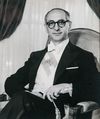
|
Arturo Frondizi (1908–1995) |
1 مايو 1958 | 29 مارس 1962 | 1958 | UCR-I | Indirect elections with Peronism barred from elections. Ousted from office by a coup d'état. | Alejandro Gómez (Resigned 18 November 1958) |
[43] | |
| شاغر | |||||||||
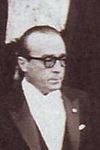
|
José María Guido (1910–1975) |
29 مارس 1962 | 12 أكتوبر 1963 | — | UCR-I | Provisional President of the Senate exercising the Executive Power, as the civil procedures to replace the deposed president were followed and Vice President Alejandro Gómez had resigned in 1958. | [44] [43] | ||
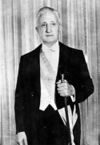
|
Arturo Umberto Illia (1900–1983) |
12 أكتوبر 1963 | 28 يونيو 1966 | 1963 | UCR-P | Indirect elections with Peronism barred from elections. Ousted from office by a coup d'état. | Carlos Humberto Perette | [45] | |

|
Junta of Commanders of the Armed Forces | 28 يونيو 1966 | 29 يونيو 1966 | — | Military | Beginning of the Argentine Revolution. Members: |
شاغر | ||
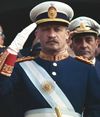
|
Juan Carlos Onganía (1914–1995) |
29 يونيو 1966 | 8 يونيو 1970 | — | Military | Coup d'état. Ousted from office. | [45] | ||

|
Junta of Commanders of the Armed Forces | 8 يونيو 1970 | 18 يونيو 1970 | — | Military | Members: | |||

|
Roberto M. Levingston (1920–2015) |
18 يونيو 1970 | 23 مارس 1971 | — | Military | Appointed by the Military Junta. Ousted from office. | [45] | ||

|
Junta of Commanders of the Armed Forces | 23 مارس 1971 | 26 مارس 1971 | — | Military | Members: | |||
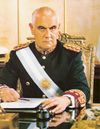
|
Alejandro Agustín Lanusse (1918–1996) |
26 مارس 1971 | 25 مايو 1973 | — | Military | Appointed by the Military Junta. End of the Argentine Revolution. Called for elections. Peronism ban lifted. | |||
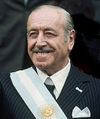
|
Héctor José Cámpora (1909–1980) |
25 مايو 1973 | 13 July 1973 | March 1973 |
PJ (FREJULI) |
Free direct elections. Because no candidate was able to get 50% of the votes needed to win, a runoff should have taken place between Cámpora and Ricardo Balbín, but Balbín decided to withdraw his candidacy, making Cámpora president. First Peronist president after the ban. Cámpora annulled the ban that remained specifically over Juan Perón, and resigned along with his Vice President. | Vicente Solano Lima | [46] | |
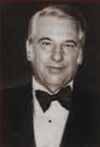
|
Raúl Alberto Lastiri (1915–1978) |
13 July 1973 | 12 أكتوبر 1973 | — | PJ | President of the Chamber of Deputies exercising the Executive Power. Alejandro Díaz Bialet, President of the Senate and ahead of Lastiri in the succession line, was on a diplomatic mission in Africa at that time. | شاغر | [47] [46] | |

|
Juan Perón (1895–1974) |
12 أكتوبر 1973 | 1 July 1974 | Sept. 1973 |
PJ (FREJULI) |
Free direct elections. Third term. Died in office. | Isabel Martínez de Perón | [46] | |
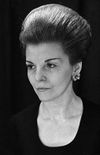
|
Isabel Martínez de Perón (1931–) |
29 يونيو 1974 | 1 July 1974 | — | PJ (FREJULI) |
First Lady and Vice President under Juan Perón. Acting president during his illness. | Herself | [48] | |
| 1 July 1974 | 24 مارس 1976 | — | Vice President of Juan Perón, assumed the presidency after his death. First female president in the Americas. Ousted from office by a coup d'état. | شاغر | |||||

|
Military Junta | 24 مارس 1976 | 29 مارس 1976 | — | Military | Beginning of the National Reorganization Process. Members: |
|||
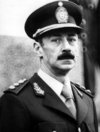
|
Jorge Rafael Videla (1925–2013) |
29 مارس 1976 | 29 مارس 1981 | — | Military | Coup d'état. President of the Military Junta. Longest government of a de facto ruler. | [49] | ||
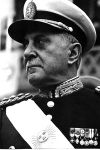
|
Roberto Eduardo Viola (1924–1994) |
29 مارس 1981 | 11 December 1981 | — | Military | Appointed by Videla as President of the Military Junta. Powers and duties suspended on 21 نوفمبر 1981 due to health problems. Ousted from office. | [49] | ||
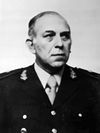
|
Horacio Tomás Liendo (1924–2007) |
21 November 1981 | 11 December 1981 | — | Military | Appointed by the Military Junta. Acting president during Viola suspension. | |||
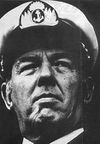
|
Carlos Lacoste (1929–2004) |
11 December 1981 | 22 December 1981 | — | Military | Appointed by the Military Junta. Interim president. | |||
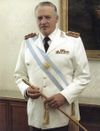
|
Leopoldo Galtieri (1926–2003) |
22 December 1981 | 18 يونيو 1982 | — | Military | Appointed by the Military Junta. Waged the Falklands War. Ousted from office. | [49] | ||
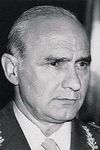
|
Alfredo Oscar Saint Jean (1926–1987) |
18 يونيو 1982 | 1 July 1982 | — | Military | Appointed by the Military Junta. Interim president. | |||
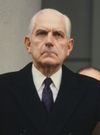
|
Reynaldo Bignone (1928–2018) |
1 July 1982 | 10 December 1983 | — | Military | Appointed by the Military Junta. End of the National Reorganization Process. Called for elections. | [49] | ||
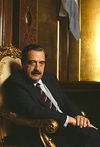
|
(Presidency) Raúl Alfonsín (1927–2009) |
10 December 1983 | 8 July 1989 | 1983 | UCR | Free indirect elections. The 1989 presidential elections were anticipated. Resigned during the transition and gave power to Carlos Menem six months in advance. | Víctor Hipólito Martínez | [50] | |
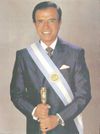
|
(Presidency) Carlos Menem (1930–) |
8 July 1989 | 8 July 1995 | 1989 | PJ (FREJUPO) |
Free indirect elections. First term. The 1994 amendment reduced the presidential term from 6 to 4 years and allowed a single consecutive reelection. | Eduardo Duhalde (Resigned 10 December 1991) |
[51] | |
| شاغر | |||||||||
| 8 July 1995 | 10 December 1999 | 1995 | PJ (UCD) |
Free direct elections. Second term. His term was extended to 10 December 1999 according to the Tenth Temporary Provision of the Constitution of 1994. | Carlos Ruckauf | ||||
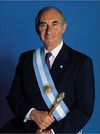
|
(Presidency) Fernando de la Rúa (1937–2019) |
10 December 1999 | 20 December 2001 | 1999 | UCR (Alianza) |
Free direct elections. Faced a severe economic crisis. Resigned after the December 2001 riots. Because his Vice President Carlos Álvarez had resigned in أكتوبر 2000, the Congress Assembled selected a new President. | Carlos Álvarez (Resigned 6 October 2000) |
[52] | |
| شاغر | |||||||||
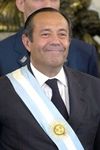
|
Adolfo Rodríguez Saá (1947–) |
22 December 2001 | 30 December 2001 | — | PJ | Elected by the Congress for three months, with instructions to call for elections. Resigned. | [53] | ||
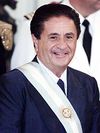
|
Eduardo Duhalde (1941–) |
2 يناير 2002 | 25 مايو 2003 | — | PJ | Elected by the Congress, with instructions to complete De la Rúa's term. Called early elections for 27 أبريل 2003. | [53] | ||
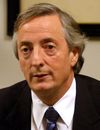
|
(Presidency) Néstor Kirchner (1950–2010) |
25 مايو 2003 | 10 December 2007 | 2003 | PJ (FPV) |
Free direct elections. Initially completed the remaining months of De la Rúa's term until 10 December 2003 then began his own mandate. Kirchner finished second to Carlos Menem in the first round and because no one was able to get 45% of the votes needed to win, a runoff should have taken place, but Menem decided to withdraw his candidacy, making Kirchner president. | Daniel Scioli | [54] | |

|
(Presidency) Cristina Fernández de Kirchner (1953–) |
10 December 2007 | 10 December 2011 | 2007 | PJ (FPV) |
Free direct elections. First term. First female president of Argentina elected as head of the list. | Julio Cobos | [55] | |
| 10 December 2011 | 10 December 2015 | 2011 | Free direct elections. Second term. By judicial ruling, her mandate ended 9 December 2015 at midnight. | Amado Boudou | [56] | ||||
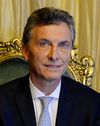
|
(الرئاسة) موريسيو ماكري (1959–) |
10 ديسمبر 2015 | 10 December 2019 | 2015 | PRO (Cambiemos) |
Free direct elections. First president elected in a ballotage, defeating Daniel Scioli. Although his mandate begun on 10 December 2015 at 00:00 hs., it was only after he swore in the Congress at 11:45 hs. that he took office as President. | Gabriela Michetti | [56] | |
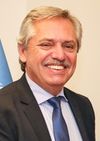
|
(الرئاسة) ألبرتو فرنانديز (1959–) |
10 ديسمبر 2019 | الحالي | 2019 | PJ (FdT) |
انتخاب مباشر حر. | كرستينا فرنانديز دى كيرشنر | ||
الخط الزمني لرئيس دولة الأرجنتين حسب الانتماء
الجدول الزمني لرئيس دولة الأرجنتين حسب الفرد
الرؤساء السابقين الذين يعيشون على طول العمر
As of 7 يناير 2026, there are six living former presidents and one incumbent president. The most recent death of a former president was that of Fernando de la Rúa (1999–2001), on 9 July 2019.
| President | Date of birth | Presidency |
|---|---|---|
| Carlos Menem | 2 يوليو 1930 | 1989–1999 |
| Isabel Martínez de Perón | 4 فبراير 1931 | 1974–1976 |
| Eduardo Duhalde | 5 أكتوبر 1941 | 2002–2003 |
| Adolfo Rodríguez Saá | 25 يوليو 1947 | 2001 |
| Cristina Fernández de Kirchner | 19 فبراير 1953 | 2007–2015 |
| Mauricio Macri | 8 فبراير 1959 | 2015–2019 |
| Alberto Fernández | 2 أبريل 1959 | 2019–present |
أنظر أيصاً
- President of Argentina
- Politics of Argentina
- List of vice presidents of Argentina
- Lists of incumbents
المصادر
- ^ Iván Ruiz and Maia Jastreblansky (February 11, 2016). "El primer sueldo de Mauricio Macri como Presidente: $131.421 brutos" [The first salary of Mauricio Macri as president: $ 131,421 gross] (in Spanish). La Nación. Retrieved February 11, 2016.
{{cite web}}: CS1 maint: unrecognized language (link) - ^ "Buenos Aires, diciembre 16 de 1829.- El primer comandante de Patricios, el primer presidente de un gobierno patrio, pudo sólo quedar olvidado en su fallecimiento por las circunstancias calamitosas en que el país se hallaba. Después que ellas han terminado, sería una ingratitud negar a ciudadano tan eminente el tributo de honor rendido a su mérito, y a una vida ilustrada con tantas virtudes, que supo consagrar entera al servicio de su patria. El gobierno, para cumplir un deber tan sagrado, acuerda y decreta: Artículo 1º: En el cementerio del Norte se levantará, por cuenta del gobierno, un monumento en que se depositarán los restos del brigadier general D. Cornelio Saavedra. Artículo 2º: Se archivará en la Biblioteca Pública un manuscrito autógrafo del mismo brigadier general, con arreglo a lo que previene el decreto de 6 de octubre de 1821. Artículo 3º: Comuníquese y publíquese. Rosas – Tomás Guido".
- ^ Rosa, vol. II, p.199-306
- ^ Rosa, vol. II, p. 306-319
- ^ Rosa, Vol. III, p. 75-114
- ^ Rosa, vol. III, p. 114-129
- ^ Rosa, vol. III, p. 143
- ^ Rosa, vol. III, p. 143-160
- ^ Rosa, vol. III, p. 160
- ^ Rosa, vol. III, p. 161-242
- ^ Rosa, vol. III, p. 242-253
- ^ أ ب ت خطأ استشهاد: وسم
<ref>غير صحيح؛ لا نص تم توفيره للمراجع المسماةRivadavia - ^ Rosa, vol. V, p.73-97
- ^ Rosa, vol. IV, p.97-117
- ^ Rosa, vol. IV, p 127-129
- ^ أ ب Rosa, vol. IV, p. 129-171
- ^ Rosa. vol. IV, p. 186-196
- ^ Rosa, vol. IV, p. 198-204
- ^ Rosa, vol. IV, p. 206-213
- ^ Rosa, vol. IV p. 219 – vol. V p. 489
- ^ أ ب Mendelevich, p. 38-41
- ^ أ ب Mendelevich, p. 42-45
- ^ Diario de Sesiones de la Cámara de Diputados del Año 1862. Tomo Primero. Buenos Aires: La Tribuna. 1863. p. 43.
- ^ Armagnague, Juan Fernando (1986). Historia del derecho: presidencias de Mitre, Sarmiento y Avellaneda. Mendoza: Ediciones Jurídicas Cuyo S.R.L. p. 17. ISBN 950-9099-09-0.
- ^ Diario de Sesiones de la Cámara de Diputados del Año 1862. Tomo Primero. Buenos Aires: La Tribuna. 1863. p. 59.
- ^ أ ب ت Mendelevich, p.46-52
- ^ Mendelevich, p. 53-56
- ^ أ ب Mendelevich, p. 57-65
- ^ أ ب Mendelevich, p. 66-72
- ^ Mendelevich, p. 73-79
- ^ أ ب Mendelevich, p. 80-88
- ^ أ ب Mendelevich, p. 89-101
- ^ أ ب Mendelevich, p. 102-112
- ^ Mendelevich, p. 113-125
- ^ Mendelevich, p. 126-129
- ^ خطأ استشهاد: وسم
<ref>غير صحيح؛ لا نص تم توفيره للمراجع المسماةJusto - ^ Mendelevich, p. 130-135
- ^ أ ب ت ث ج خطأ استشهاد: وسم
<ref>غير صحيح؛ لا نص تم توفيره للمراجع المسماةOrtiz - ^ Mendelevich, p. 136–155
- ^ Mendelevich, p. 145
- ^ Mendelevich, p. 156-176
- ^ أ ب Mendelevich, p. 177-186
- ^ أ ب Mendelevich, p. 187-195
- ^ Mendelevich, p. 193
- ^ أ ب ت Mendelevich, p. 196-214
- ^ أ ب ت Mendelevich, p. 215-228
- ^ Mendelevich, p. 223
- ^ Mendelevich, p. 229-235
- ^ أ ب ت ث Mendelevich, p. 236-241
- ^ Mendelevich, p. 242-245
- ^ Mendelevich, p. 247-252
- ^ Mendelevich, p. 253-262
- ^ أ ب Mendelevich, p. 263-277
- ^ Mendelevich, p. 278-282
- ^ Mendelevich, p. 283-292
- ^ أ ب "La jueza Servini declaró que el mandato de Mauricio Macri comienza a las 0 horas del día 10 de diciembre". Agencia de Noticias del Poder Judicial. 9 December 2015.
ملاحظات
- ^ Catamarca, Córdoba, Mendoza, Santa Fe, Salta, Santiago del Estero and Tucumán accept Mitre as the person in charge of the National Executive Power. Buenos Aires, San Juan and Jujuy only gave Mitre the authority to manage international relations, to convene the National Congress, and to rule on urgent internal business. Corrientes, La Rioja and San Luis only gave Mitre the authority to manage international relations and to convene the National Congress. Entre Ríos only gave Mitre the authority to convene the National Congress.
قائمة المصادر
- Mendelevich, Pablo (2010). El Final (in Spanish). Buenos Aires: Ediciones B. ISBN 978-987-627-166-0.
{{cite book}}: CS1 maint: unrecognized language (link) - Rosa, José María (1974). Historia Argentina (in Spanish). Buenos Aires: Editorial Oriente S.A.
{{cite book}}: CS1 maint: unrecognized language (link) - Abal Medina (h.), Juan; Suárez Cao, Julieta (August 2003). "Análisis crítico del sistema electoral argentino. Evolución histórica y desempeño efectivo". Revista de Ciencias Sociales (in Spanish). Bernal: National University of Quilmes. 14.
{{cite journal}}: CS1 maint: unrecognized language (link)
وصلات خارجية
- Rulers.org — Argentina list of rulers for Argentina
- صفحات تستخدم خطا زمنيا
- Short description is different from Wikidata
- Articles with hatnote templates targeting a nonexistent page
- مواليد 2 يوليو
- مواليد 1930
- سنة الميلاد مختلفة في ويكي بيانات
- شهر الميلاد مختلف في ويكي بيانات
- يوم الميلاد مختلف في ويكي بيانات
- مواليد 4 فبراير
- مواليد 1931
- مواليد 5 أكتوبر
- مواليد 1941
- مواليد 25 يوليو
- مواليد 1947
- مواليد 19 فبراير
- مواليد 1953
- مواليد 8 فبراير
- مواليد 1959
- مواليد 2 أبريل
- قوائم رؤساء الدول
- قوائم الرؤساء الوطنيين
- رؤساء دول الأرجنتين
- قوائم أصحاب المناصب السياسية في الأرجنتين
